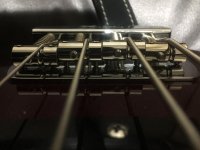Hey everyone, I just received a brand new Stingray Special. It is wonderfully light weight and the finish is just out of this world. With that said, I needed to do a bit of a set up as usual and have to adjust the string height, something I've done a thousand times in over 30 years playing, maintaining and building my own basses. The saddle screws will tighten with no problem. They will also loosen a little bit but at after 1 full turn they will not turn any further. It just locks up like you've gotten the saddle to hit the bridge plate but that is not the case. I'm wondering if there are bad threads on the screws. I put some Big Bends Nut Sauce on the threads to perhaps lubricate it but still it doesn't go past the same spot. I don't want to put too much torque on the allen wrench or the screw in fear of stripping the screw head or damaging the threads. Any suggestions would be much appreciated.
Merry Christmas and Happy Holidays to all.
Merry Christmas and Happy Holidays to all.



